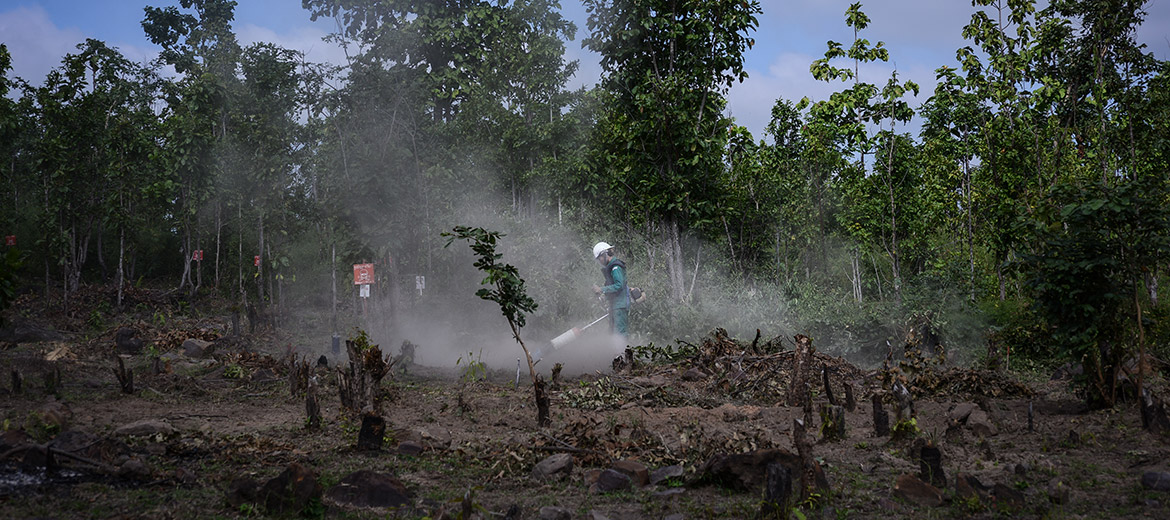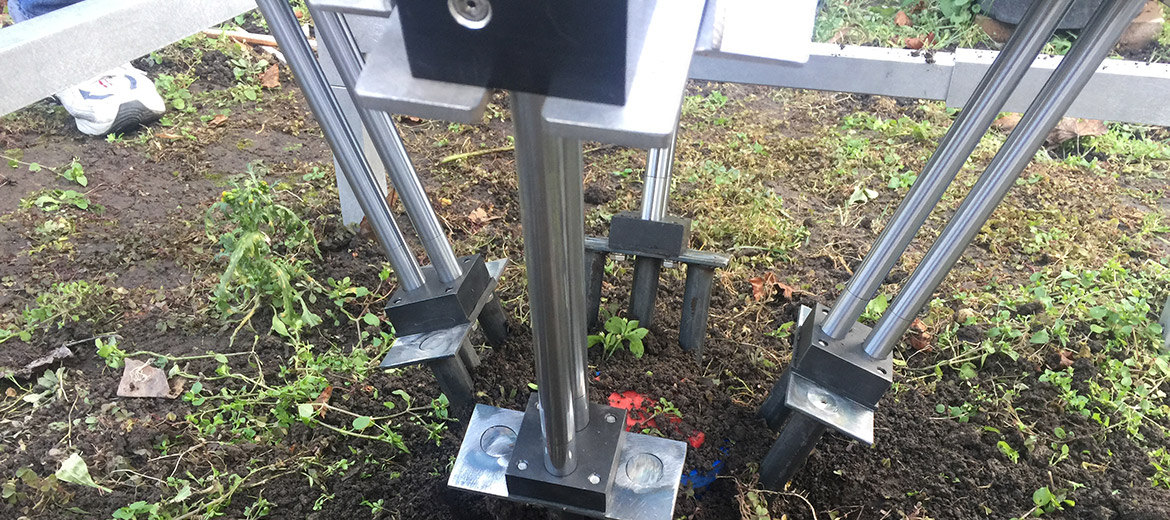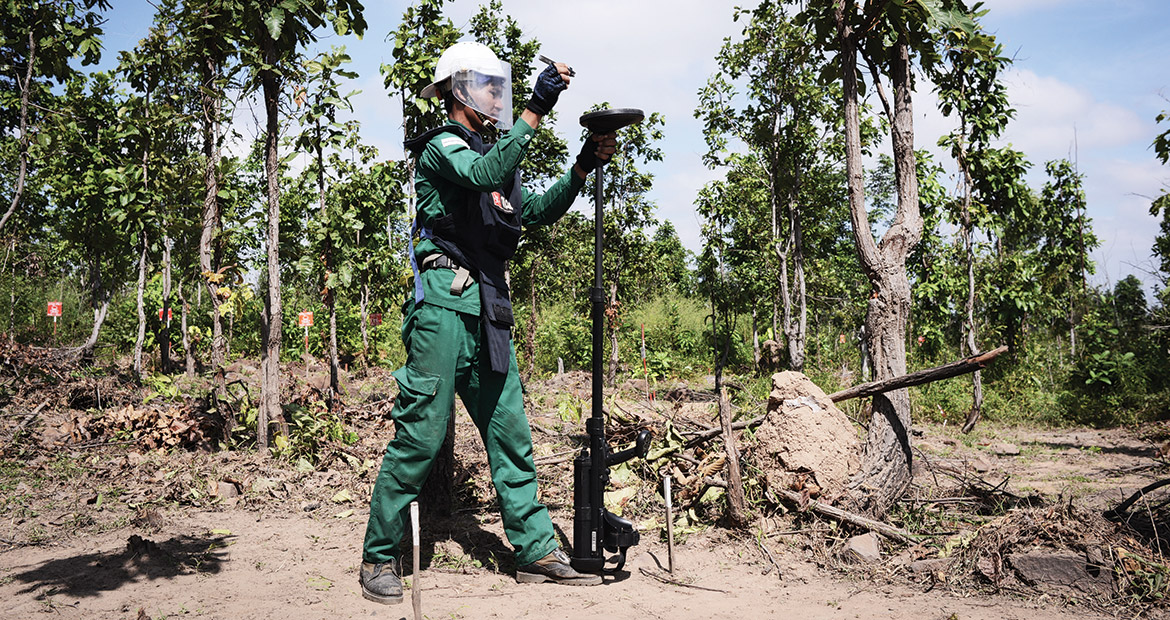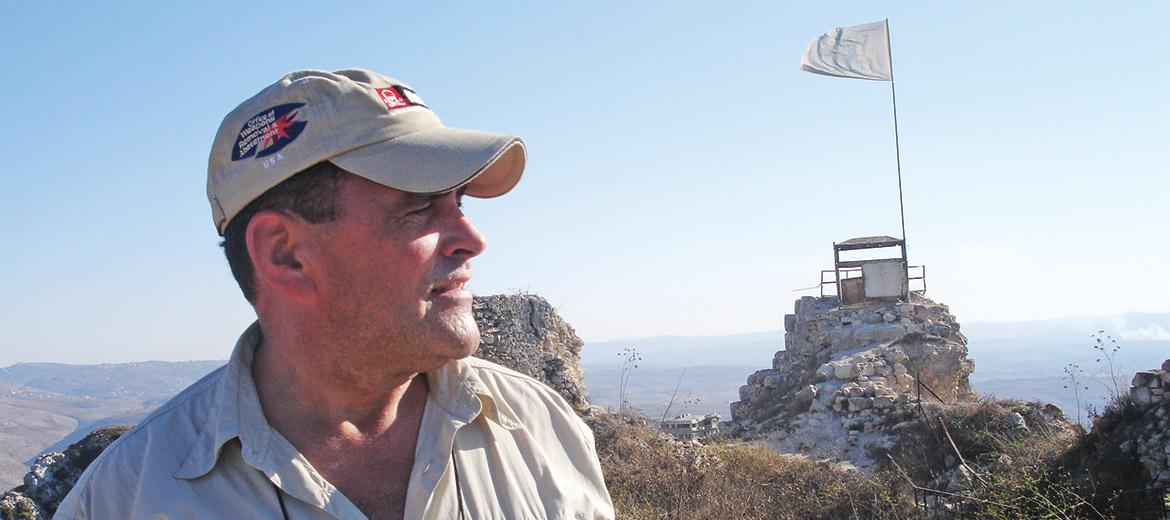On any given day, thousands of Cambodia’s deminers put on their protective gear and head out into forests and fields littered with weapons buried decades ago, still set to explode as soon as a person or vehicle presses down. They chop away at the vines and bushes that have grown over terrain on which one wrong step could be their last. Some use a machine designed for clearing vegetation, others use hand tools. Once the land is cleared of brush, they can begin the painstaking process of locating and removing bombs lying just centimetres beneath the surface.
Creeping along with a metal detector, they wait for a beep and leave a marker, knowing that at least nine times out of ten it’s going to be a harmless metal item that poses no danger to anyone. After combing the whole area, they delicately prod the area around each marker with a stick to check the size of the object found beneath the ground, before cautiously excavating anything that might be a landmine. If it is, they remove the detonator and place the mine along with the rest of the day’s haul in a pile that will eventually be exploded.
It is dangerous, painstaking work that deserves great applause but, amid rapid innovations in other fields, there must be a better way to get it done – or at least that is the notion driving Richard Yim.
An engineering graduate from the University of Waterloo in Canada, Yim’s first encounter with landmines came when he was eight years old and growing up in Phnom Penh, when his aunt died after stepping on one of the fist-sized devices. A decade later, and halfway around the world in Canada, he started the Landmine Boys, a company rebranded this month as Demine Robotics, which is developing technology meant to help eradicate landmines with minimal human exposure to the explosive devices.
“This is for the country, this is for the world, this is for those countries that still have landmines and the thousands of people who suffer because of landmines and the millions more who are restricted of land and denied the ability to take part in agricultural activities because of landmines,” Yim said.
Drawing on his technical expertise, Yim created two machines to enter the demining process in place of humans. One is designed with arms that plunge under a mine to lift it out of the ground, uncovering the detonator for the second machine, which pinches and disables the trigger before slicing into the mine and melting the explosive material inside.

Yet apart from the many technical challenges of his endeavour, Yim also joins a long list of well-intentioned innovators who have found that carrying out field tests that win over key players in the demining sector is the ultimate obstacle. Research at universities and technology companies might seem convincing on paper, but there are more examples of failures than successes when it comes to new inventions in the industry. There is no disagreement, however, with the notion that the current mine clearance process in Cambodia can be improved.
When Cambodia signed the Ottawa Treaty in 1997, almost eight Cambodians stepped on landmines every day. That figure has dropped drastically; last year marked the first time that overall casualties due to landmines fell to less than 100. Yet Cambodia remains the second most mined country in the world and has the highest number of landmine victims per capita.
The Ottawa Treaty committed Cambodia to eradicating all of their landmines by 2010. And though it has not hit that target – the deadline has now been pushed back to 2025 – the government still needs to follow through on the agreement, said Paul Hannon, executive director of Mines Action Canada.
“They have to solve the problem and it’s not just because they joined the Ottawa Treaty. They need to do this for the people living and working in Cambodia, for their own citizens. It’s just not an acceptable danger, particularly when it is a solvable problem,” Hannon said.
A daunting question mark continues to loom over the approaching deadline of 2025 – even in the eyes of those most responsible for hitting the target.
“Our commitment is to try to finish by 2025,” said Tan Sara, unit manager for the Cambodian Mine Action Authority (CMAA) database. “But just my personal idea, we cannot say that it will be completed. We cannot see the mines underground. We are not gods. The mines can move sometimes and the mines are always in different soils.”

The CMAA database is the national authority’s compilation of all available data on mine action in Cambodia and serves as the basis of information for policy creation. Ly Tuch, the senior minister in charge of the authority, said that he was optimistic about the future of demining innovation but also aware of its limitations.
“Hopefully in the future technology will replace most of our efforts made by human beings so that we reduce accidents,” he said, adding that “sometimes big machines and equipment cannot perform in these conditions because of the forest, the trees, th mountains”.
Thus far, the government has relied almost entirely on foreign funding in efforts to clear mines and unexploded ordnance (much of which was also purchased and planted with foreign support). And while NGOs in the sector are in agreement that the government is almost sure to miss its target of being landmine-free by 2025 with current rates of demining, many remain unconvinced that technological innovation is going to be a game changer, or any help at all.
Experts in the sector say they are all too familiar with inventors who skip steps in developing their models or fail to effectively integrate the reality of the situation in the countries where they would be deployed. Some say that universities, rather than encouraging gradual improvements on existing technology, encourage engineers to pursue ideas that are both outside the box and utterly impractical.
“I think part of the drive of universities is to look to get the grant rather than to look to get the actual objective on the ground, and they have to change their motivation in a lot of ways,” said Lou McGrath, a prominent figure in the mine action sector who co founded Mines Advisory Group (MAG), one of the largest demining NGOs in the world. McGrath now serves as CEO of Find A Better Way, an NGO that supports practical innovation in the sector. “This isn’t about just filling the time of a PhD student or whatever,” he added.

Just last October, Darren Ansell, a researcher at the University of Central Lancashire in the UK, arrived in Cambodia for the first time with a team of academics. They brought with them drones that came equipped with high-tech infrared cameras that could theoretically spot abnormalities in the forest cover in order to spot where mines were likely located.
“We don’t really understand the challenge out in Cambodia,” Ansell admitted. “It was more of a fact-finding operation to find out whether drones could be used to help with mine clearance in any way… We’d never been to an active minefield before, but we were familiar with how the drones operate.”
Ansell and his team returned to Cambodia last month to train deminers in how to operate their drones, but most experts in the sector have already decided that drones are most useful to demining in the way they are already being used – mapping areas that will then be combed by humans in order to pinpoint the location of mines.
Yim has prioritised practicality and in-the-field knowledge in the work of Demine Robotics, going as far as personally enrolling in a programme to become a certified deminer in Cambodia.
“We want to build something practical that can be used as soon as possible,” he said. But some are doubtful that the machines will work at all. One sceptic of Yim’s machines is Greg Crowther, South and Southeast Asia Regional Director for MAG. Crowther has worked in mine clearance for decades and said he has seen countless attempts at drastic innovation in the industry – an overwhelming number of which have been resounding failures.
“If you’re just innovating for the sake of innovating then it’s a waste of everyone’s time and resources,” he said. “Whatever you design in a field in Canada or a dummy minefield in Switzerland, when it hits the ground in Cambodia, or Angola, or South Sudan it’s a different story.”

Where these inventors often create `magic’ devices, as Crowther described them, they rarely serve a functional purpose. This discrepancy has led him to draw a fine line between innovation and invention.
“Everybody needs inventors, that’s important. That’s not innovation. Innovation is something which builds on existing techniques and existing processes and you innovate by improving them,” he said.
Yim still sees his machines as being practical despite relying on radically new technology. “We are looking to build upon a basis of technology… We would do exactly what human deminers do except faster and it doesn’t actually put the deminer in danger,” he said.
He claimed the estimated price of the machines, at roughly $50,000 each, is comparable to the cost of training and maintaining a team of mine-detecting dogs for one month, according to figures from MAG. If the machines function as Yim hopes, they could excavate a landmine in five minutes with an estimated 75% increase in efficiency. But he still has to prove that they can work.
“You can create this technology, but it might be incredibly expensive to use and may not be repairable, [or] you may have a fantastic new piece of equipment, but it may be really hard to get to rural Cambodia or the border areas that are much more remote, and if it breaks down how do you repair it,” said Hannon of Mines Action Canada, who has been working with Yim since the Landmine Boys launched.
“I and others need to have a healthy dose of scepticism as well as encouraging [Yim] because it’s dangerous stuff we’re talking about here and we need to make sure we get it right.”


